| Chilkoot Trail |
|
| The Chilkoot Trail has been called the “meanest thirty-two miles in history.” It follows the trail the stampeders used to reach the Yukon River and float their provisions to the gold fields of the Klondike. | |
| No
single image better conjures the human drama of the 1898 gold rush than
the lines of prospectors struggling over the Chilkoot Trail , a
53-kilometre path over the Coast Mountains between Dyea , north
of Skagway in Alaska, and Bennett Lake on the British Columbian
border south of Whitehorse.
The final climb to the summit, a distance of ¾ mile, was so steep that steps were cut into the snow and ice to keep the stampeders from slipping down the nearly 45-degree slope. This portion of the trail got a nickname, the “Golden Stairs”, and it was so difficult that many stampeders turned back at this point. |
|
| Before
the rush, Dyea was a small village of Chilkat Tlingit, who made annual
trade runs over the trail to barter fish oil, clamshells and dried fish
with the Tutchone, Tagish and other interior Dene peoples in exchange
for animal hides, skin clothing and copper. The Chilkat jealously
guarded access to the Chilkoot Pass (1122m), the key to the trail
and one of only three glacier-free routes through the Coast Mountains
west of Juneau. Sheer numbers and a show of force from a US gunboat,
however, opened the trail to stampeders, who used it as a link between
the ferries at the Pacific Coast ports and t |
|
| For
much of 1897, the pass and border were disputed by the US and Canada
until the Canadian NWMP (Northwest Mounted Police) established a
storm-battered shack at the summit and enforced the fateful "ton of
goods" entry requirement. Introduced because of chronic shortages
in the gold fields, this obliged every man entering the Yukon to carry a
ton of provisions - and, though it probably saved many lives in the long
run, the rule laid enormous hardship on the back of the stampeders. |
|
|
|
|
| Weather conditions and the trail's fifty-degree slopes proved too severe even for horses or mules, so that men had to carry supplies on their backs to move their "ton of goods". By dividing their goods into 50-pound bundles and making 30 to 40 trips, the relatiely short hike of 33 miles turned into a 1320-mile journey. Many died in avalanches or lost everything during a winter when temperatures dropped to -51°C and 25m of snow fell. Even so, the lure of gold was enough to drag some 22,000 prospectors over the pass. | |
|
|
|
| The trail is well marked, regularly patrolled and generally fit to walk between about June and September, though throughout June you can expect snow on the trail. Most people hike the trail in three or four days and if you're moderately fit it shouldn't be a problem, but there are dangers from bears, avalanches, drastic changes of weather and exhaustion - there's one twelve-kilometre stretch that includes the Golden Stairs, for which you're advised to allow twelve hours. Almost everyone hikes from south to north. | |



